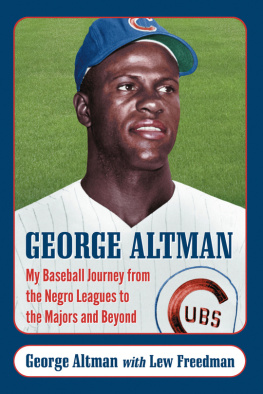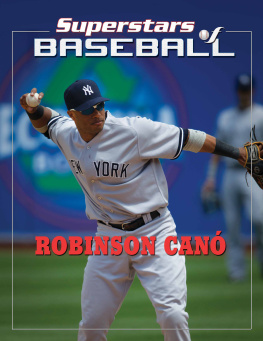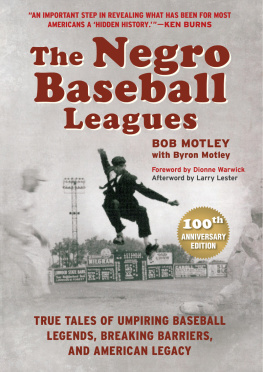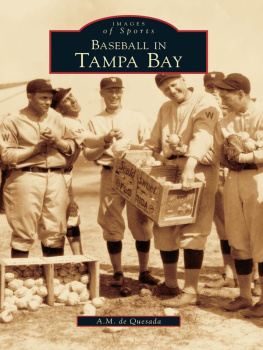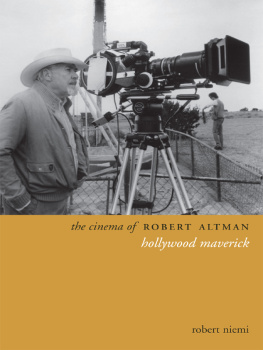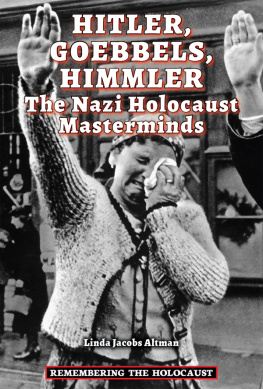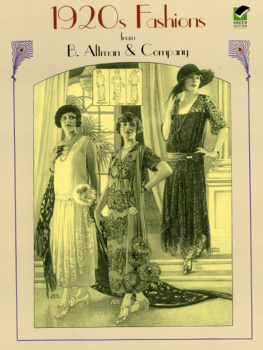
George Altman
My Baseball Journey from the Negro Leagues to the Majors and Beyond
GEORGE ALTMAN
with Lew Freedman

McFarland & Company, Inc., Publishers
Jefferson, North Carolina, and London
All photographs courtesy of George Altman
LIBRARY OF CONGRESS CATALOGUING DATA ARE AVAILABLE
BRITISH LIBRARY CATALOGUING DATA ARE AVAILABLE
e-ISBN: 978-1-4766-0291-2
2013 George Altman and Lewis H. Freedman. All rights reserved
No part of this book may be reproduced or transmitted in any form or by any means, electronic or mechanical, including photocopying or recording, or by any information storage and retrieval system, without permission in writing from the publisher.
Front cover: George Altman of the Chicago Cubs (National Baseball Hall of Fame Library Cooperstown, New York)
McFarland & Company, Inc., Publishers
Box 611, Jefferson, North Carolina 28640
www.mcfarlandpub.com
I would like to dedicate this book rst of all to God who gave me the talent and strength to persevere through all of my adversities and setbacks.
Also to my mother, whom I never really knew. Everyone who knew her said that she was a beautiful, kind and loving person. I have tried to use her legacy as a guideline for my life.
And to my wonderful and loving wife Etta, to my children, relatives and friends who gave me love, comfort and support.
I am grateful and thankful to my coaches, Cash, McLendon, Simmons, Whitmon, and especially Buck ONeil.
Introduction by Lew Freedman
George Altman had the most diverse baseball career of anyone who ever played the game.
Altman, who was born in Goldsboro, North Carolina, in 1933, not only played the game as a youth, but he competed at Tennessee State University, while in the United States Army, for the Kansas City Monarchs in the old Negro Leagues, in the minors, and in winter ball in Panama and Cuba. He spent nearly a decade in the majors with the Chicago Cubs, St. Louis Cardinals, and New York Mets, and also became one of the early former big-leaguers to play in Japan. Wherever they rolled out the bats and balls, George Altman was not far behind. With the Monarchs, Altman played for the legendary Buck ONeil as his manager. Rangy and quick-wristed at the plate, Altman was twice named a National League All-Star with the Cubs. Later, he extended his career by playing eight seasons in Japan, most of them with the Tokyo Orions but also with the Hanshin Tigers.
Altman was nicknamed Big George. His 6-foot-4 height also made him a superb basketball player earlier in life, and he suggests that despite his all-around success in baseball that hoops may even have been his best sport.
After retiring from baseball, Altman chose racquetball as his favorite sport for conditioning and competition. He played competitively for more than 20 years and won a few trophies. More recently, he moved on to horseshoes, an endeavor he calls much less strenuous. Altman has continued to compete in that sport and has won tournaments in his age division.
Among his variety of achievements in the majors, Altman saved a no-hitter with the Cubs with a ninth-inning outeld catch, led the National League in triples, hit a pinch-hit home run in the All-Star Game, and in a rarity given the Hall of Fame pitchers wizardry at the time, Altman hit two home runs in one game off Sandy Koufax. A different kind of accomplishment was becoming at least semi-conversant in Japanese.
Only a few major leaguers of a certain age passed through the Negro Leagues before they reached the majors and also experimented with playing in Japan. No one else, however, also played college baseball and service ball, minor-leagues, and winter ball, besides Altman. His was a unique baseball career, one that began in neighborhood play, just like that of millions of other little boys before Little League became an ofcial option.
Altman actually attended Tennessee State, then an NAIA school, on a basketball scholarship, though as a youth he started playing baseball rst. Being tall helped direct Altman to the hardwood, and being in school already helped redirect him to the baseball diamond again.
Almost no one in Altmans family participated in sports during his youth, so he had to nd his own way. He came from a family of automobile mechanics, not outelders or dribblers. When Altman went off to college in Tennessee he thought he might become a high school basketball coach when he nished, or go into the business eld if the opportunity came along.
A mutual friend connected Altman to the Monarchs, one of the signature franchises of the Negro Leagues, which were then fading out since the majors had committed to integration. Altman spent enough time with the gracious, informative, and wise Buck ONeil to get a head start in the game.
Very briey, during one of his stretches with the Monarchs, Satchel Paige dazzled the young Altman, too. I felt like I was playing on hallowed ground, Altman said of sharing a eld with the legendary Paige, perhaps the greatest pitcher who ever lived. To be on the same team as Satchel Paige and sit around listening to him tell stories was pretty special. I had heard so much about him and the older guys.
Altmans short association with ONeil in Kansas City paid dividends. As the venerable Monarchs disappeared, ONeil joined the Chicago Cubs as a scout (and later became the majors rst African American coach with the team). ONeil recommended several black players to the Cubs who had played together on the 1955 Monarchs, and Altman, Lou Johnson and J. C. Hartman all signed and made the majors.
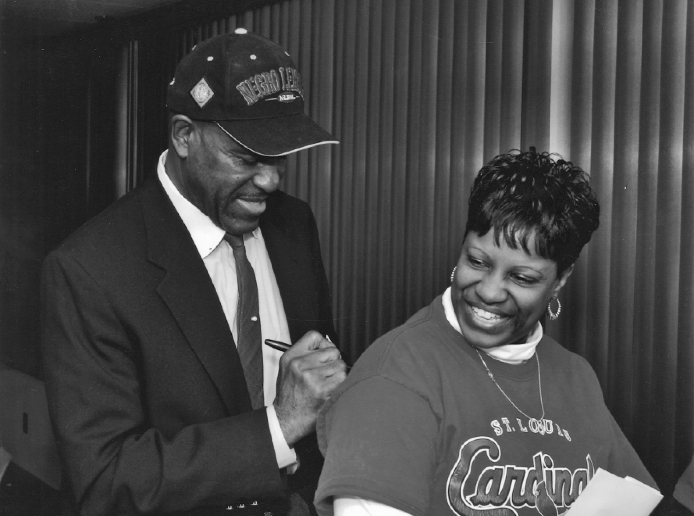
George Altman signing an autograph at a Negro Leagues Museum function in Kansas City.
It was not for big money. Laughing as he told the tale, Altman said the Wrigleys, the team owners, did not exactly pay large bonuses.
We got a pack of chewing gum from Wrigley, Altman joked.
By the time he got out of the Army and made an impression in the minors, Altman was already 26 years old. In spring training of 1959, Altman came to camp with a AAA contract. But he hit very well, smacking line drives all over the complex and batting about .340. He also possessed more speed than almost anyone else around and out-raced other guys regularly. Manager Bob Schefng liked the look of the hard-hitting outelder and asked Altman if he could play center eld. Naturally, he said yes because he wasnt going to pass up an opportunity, though he had only dabbled in center eld as a youth.
When it came time for Altmans major league debut, the Cubs opened the season at home in venerable Wrigley Field. However, in keeping with Chicagos irregular brand of weather, snow akes fell during Altmans rst game against the Los Angeles Dodgers as part of the opening day dcor.
Altman was fairly successful dodging snowfall that day, in a game played in 42-degree temperatures, but was less successful dodging the fastballs thrown by future Hall of Fame right-hander Don Drysdale, who was known for brushing hitters back. On the rst pitch of Altmans major league career, he was struck by a Drysdale fastball. Altmans clearest memory of the rst game of his big-league career was not any bruise incurred from Drysdales errant pitch, though. He just remembers hoping that every day in Chicago wouldnt be so cold.
Next page
